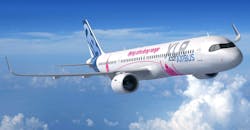Airbus Starts Assembly for Extra Long-Range Jets
Airbus SE reports it has started producing major components for the first A321XLR aircraft, at its own plants and among its supplier partners, toward “major component assembly” of the first forward fuselage, center fuselage, and rear fuselage sections, as well as the wings. Those assembly efforts will begin this year.
Airbus introduced the A321XLR at the 2019 Paris Air Show as a new variant of the A321LR (the long-range version of the A321neo series.) It will have a range of up to 4,700 nm (8,700 km, or 5,400 miles); and 30% lower fuel consumption per seat than previous-generation jets. The maximum takeoff weight (MTOW) will be 101 metric tons (111 tons), and takeoff, climb, and flight performance will be comparable to the A321neo.
The narrow-body aircraft will be powered by twin geared-turbofan engines (CFM International LEAP-1A, or Pratt & Whitney PW1000G) and piloted by the same flight crews as the current A321neo aircraft.
Airbus has logged over 400 orders for the new model, which is expected to be ready for commercial operation by 2023.
Airbus explained that all major sections of the A321XLR contain significant design changes versus the current A321neo/A321LR baseline aircraft, but the significant design and manufacturing differences will be for the center and aft fuselage – mainly due to a new, integral rear-center fuel tank and associated fuel management systems, which are critical to the aircraft’s “eXtra Long Range” performance capability.
“The production of components for the first A321XLR flight-test aircraft is progressing through the sites all across the world, for large and small components as well as systems,” stated Gary O’Donnell, who heads the A321XLR program. “In parallel many parts are already being tested and demonstrated – on both the aircraft structure and on the systems side – to validate the functionality of all those first aircraft components.”
